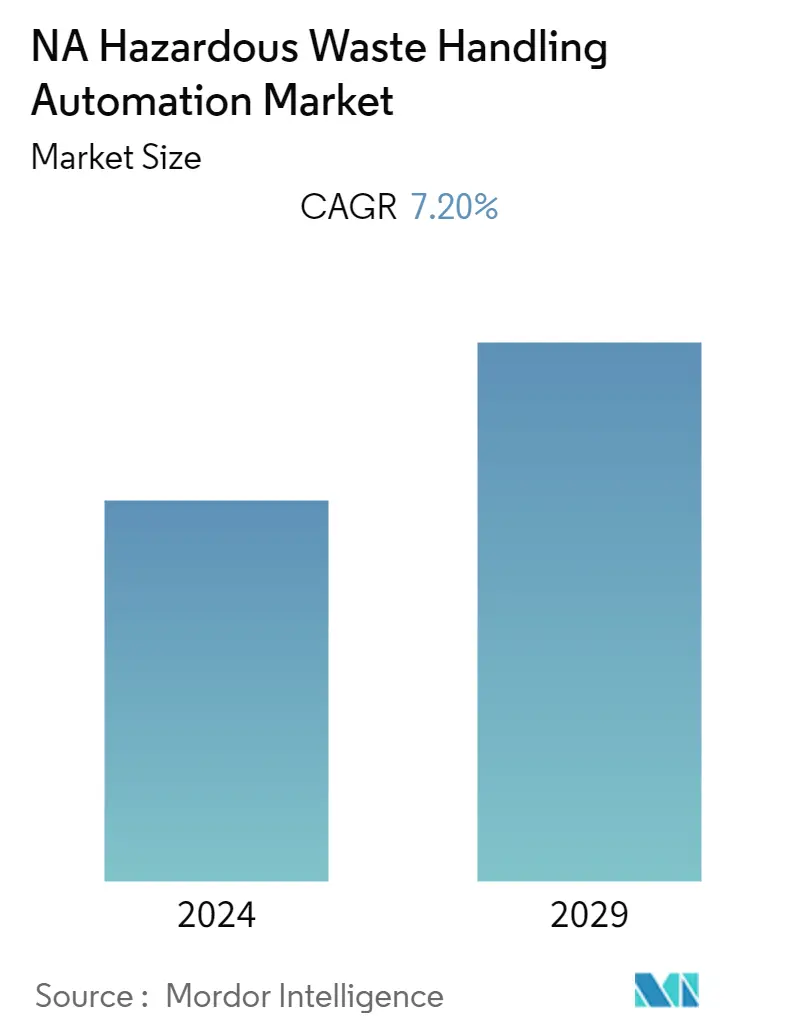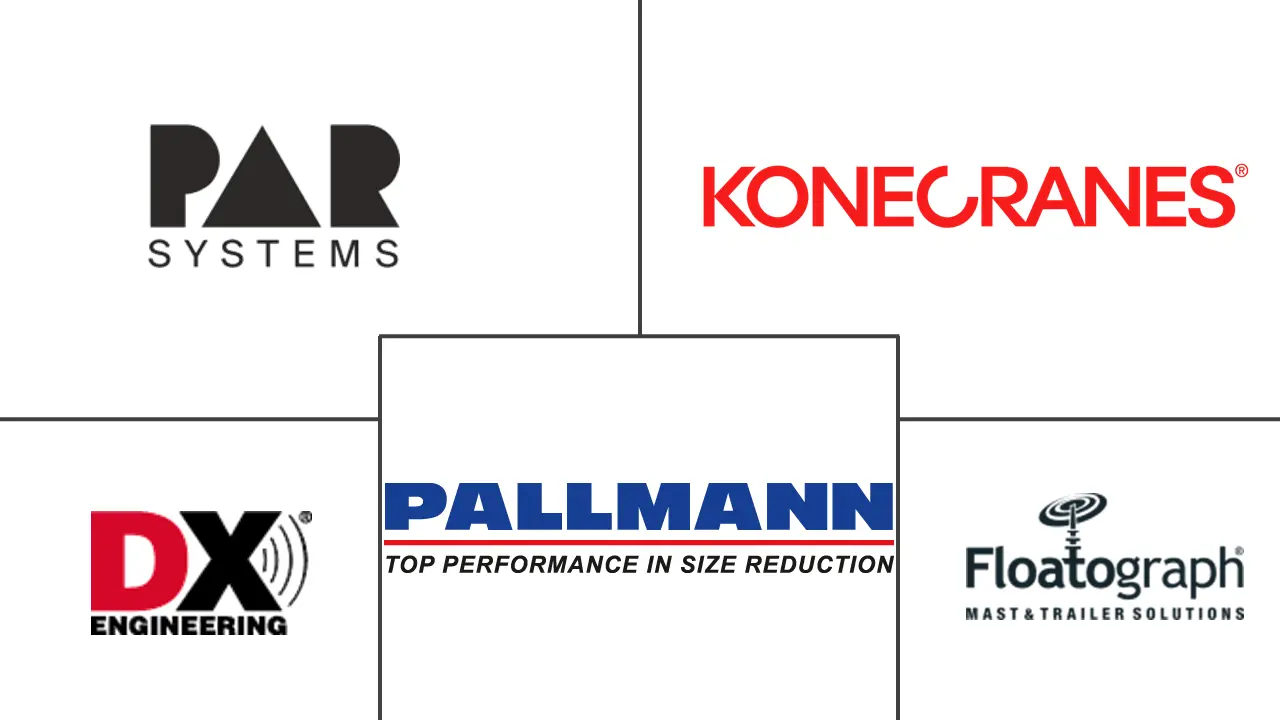Market Size of NA Hazardous Waste Handling Automation Industry

| Study Period | 2019 - 2029 |
| Base Year For Estimation | 2023 |
| Forecast Data Period | 2024 - 2029 |
| Historical Data Period | 2019 - 2022 |
| CAGR | 7.20 % |
| Market Concentration | Medium |
Major Players
*Disclaimer: Major Players sorted in no particular order |
North America Hazardous Waste Handling Automation Market Analysis
The North American hazardous waste handling automation market is expected to grow, registering a CAGR of 7.2% during the forecast period. The market is fueled by increased industrial activity, a rise in production and manufacturing-related waste, and government and industry regulations on managing hazardous waste.
- Automating hazardous waste handling is the method of handling hazardous waste with machines. This can range from classifying and moving the material to actually destroying it. Automation of hazardous waste handling is growing in popularity as businesses explore for solutions to lessen their environmental effect.
- The North American hazardous waste handling automation market is likely to grow significantly over the forecast period as a result of severe governmental and industrial laws designed to keep people safe from hazardous waste in light of the harm caused to people and the environment.
- Because of the rising adoption of automation in the waste management process, the United States is predicted to dominate the North American hazardous waste handling automation market during the forecast period. The region's most recent technology innovations and adoptions have aided in developing dangerous new waste-handling automation products that can improve overall operations and accuracy in several applications.
- Although the American public views hazardous waste as a severe environmental problem, the social and environmental issues brought on by its high development and buildup rates have not received considerable consideration. Because of this, organizations like the EPA have worked to create hazardous waste rules that strike a balance between resource conservation and maintaining the protection of human health and the environment. While particular dangerous wastes can be processed and disposed of in landfills or incinerators, other wastes must be treated and recycled safely and effectively.
- According to the US Energy Information Administration, around 85 pounds of MSW can be burned as fuel to produce energy for every 100 pounds of MSW in the US as of December 2022. Trash-to-energy facilities reduce waste volume by roughly 87% and turn 2,000 pounds of garbage into ash that weighs between 300 and 600 pounds. A massive crane claw gathers rubbish and deposits it in a combustion chamber while generating power in a mass-burn waste-to-energy plant.
- Decomposing or neutralizing hazardous waste has also become difficult due to the need to create new technologies for hazardous waste management. Businesses in the hazardous waste management industry are constantly trying to develop innovations and solutions to problems.
- Furthermore, several non-government organizations (NGOs) and community-based organizations (CBOs) are stepping in to help hospitals and other healthcare facilities collect, recycle, and dispose of medical waste. Such initiatives are expected to boost further the adoption of automation solutions for waste management.
- An exclusive partnership was formed between environmental solutions provider US Ecology and machine learning technology company Smarter Sorting to provide retailers with an automated solution to more safely and compliantly classify and segregate RCRA, hazardous and non-hazardous waste. The exclusive partnership between US Ecology and Smarter Sorting was the first collaboration to incorporate artificial intelligence into the supply chain of retail products classified as waste.
- Several government organizations, such as the Food and Drug Administration (FDA), Environment Protection Agency (EPA), and Drug Enforcement Administration (DEA), are also consistently working toward the proper management of waste to ensure safety from hazardous medical, chemical, and radioactive wastes.
North America Hazardous Waste Handling Automation Industry Segmentation
Hazardous waste management is a process to ensure that the handling, storage, and disposal of hazardous waste is done in a way that protects both human and environmental health and safety.
The North American Hazardous Waste Handling Automation Market is segmented by Type of Waste (Listed Wastes, Characteristic Wastes, Universal Wastes, and Mixed Wastes), Product (Manipulator Arms, Telescoping Masts, Cranes, Trusses, and Size Reduction Systems), End-user Industry (Manufacturing, Chemical, Energy, Consumer Care, and Government), and Country. The market sizes and forecasts are provided in terms of value (USD million) for all the above segments.
| By Type of Waste | |
| Listed Wastes | |
| Characteristic Wastes | |
| Universal Wastes | |
| Mixed Wastes |
| By Product | |
| Manipulator Arms | |
| Telescoping Masts | |
| Cranes | |
| Trusses | |
| Size Reduction Systems | |
| Other Products |
| By End-user Industry | |
| Manufacturing | |
| Chemical | |
| Energy | |
| Consumer Care | |
| Government | |
| Other End-user Industries |
| By Country | |
| US | |
| Canada |
NA Hazardous Waste Handling Automation Market Size Summary
The North American hazardous waste handling automation market is poised for significant growth, driven by increased industrial activity and stringent government regulations aimed at managing hazardous waste. Automation in this sector involves the use of machines to handle, classify, and dispose of hazardous materials, which is becoming increasingly popular as businesses seek to reduce their environmental impact. The United States is expected to lead the market due to its advanced technological innovations and the adoption of automation solutions that enhance operational efficiency and accuracy in waste management processes. The market's expansion is further supported by partnerships and collaborations between companies and organizations focused on improving waste handling practices, such as the collaboration between US Ecology and Smarter Sorting, which integrates artificial intelligence into waste classification and segregation.
The market's growth is also fueled by the rising awareness of environmental issues and the need for effective waste management solutions in the face of increasing industrialization and urbanization. The manufacturing sector, a significant contributor to hazardous waste generation, underscores the importance of automation to ensure safe disposal and minimize environmental impact. Companies like PegEx Inc. are leveraging cloud-based platforms to enhance productivity and reduce risks in waste management. Additionally, regulatory bodies and NGOs are actively working to promote safe waste handling practices, further driving the adoption of automation solutions. The competitive landscape in North America is characterized by strategic investments, product launches, and partnerships, as companies strive to capitalize on the growing demand for hazardous waste handling automation.
NA Hazardous Waste Handling Automation Market Size - Table of Contents
-
1. MARKET INSIGHTS
-
1.1 Market Overview
-
1.2 Industry Attractiveness - Porter's Five Forces Analysis
-
1.2.1 Bargaining Power of Suppliers
-
1.2.2 Bargaining Power of Consumers
-
1.2.3 Threat of New Entrants
-
1.2.4 Threat of Substitutes
-
1.2.5 Intensity of Competitive Rivalry
-
-
1.3 Assessment of the Impact of COVID-19 on the Market
-
-
2. MARKET SEGMENTATION
-
2.1 By Type of Waste
-
2.1.1 Listed Wastes
-
2.1.2 Characteristic Wastes
-
2.1.3 Universal Wastes
-
2.1.4 Mixed Wastes
-
-
2.2 By Product
-
2.2.1 Manipulator Arms
-
2.2.2 Telescoping Masts
-
2.2.3 Cranes
-
2.2.4 Trusses
-
2.2.5 Size Reduction Systems
-
2.2.6 Other Products
-
-
2.3 By End-user Industry
-
2.3.1 Manufacturing
-
2.3.2 Chemical
-
2.3.3 Energy
-
2.3.4 Consumer Care
-
2.3.5 Government
-
2.3.6 Other End-user Industries
-
-
2.4 By Country
-
2.4.1 US
-
2.4.2 Canada
-
-
NA Hazardous Waste Handling Automation Market Size FAQs
What is the current NA Hazardous Waste Handling Automation Market size?
The NA Hazardous Waste Handling Automation Market is projected to register a CAGR of 7.20% during the forecast period (2024-2029)
Who are the key players in NA Hazardous Waste Handling Automation Market?
DX Engineering, PaR Systems Inc., Konecranes PLC, Floatograph Technologies and Pallmann are the major companies operating in the NA Hazardous Waste Handling Automation Market.

